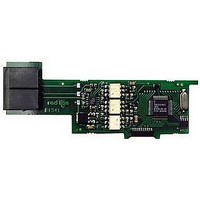PAXCDC40 Red Lion Controls, PAXCDC40 Datasheet - Page 9

PAXCDC40
Manufacturer Part Number
PAXCDC40
Description
Modbus Communications Network Interface Card
Manufacturer
Red Lion Controls
Specifications of PAXCDC40
Accessory Type
Modbus Communications Network Interface Card
Brand/series
PAX Series
Card Type
Extended Modbus Communications Card
Data Rate
7⁄8 Bits
Standards
cULus Listed, CSA Certified and CE Marked
Voltage, Working
50 V
Pax Label Kit
189 Different Engineering Units, Labels Inserted Inside the Unit
For Use With
Red Lion PAX Digital Input Panel Meters
Lead Free Status / RoHS Status
Lead free / RoHS Compliant
WIRING OVERVIEW
back of the meter. All conductors should conform to the meter’s voltage and
current ratings. All cabling should conform to appropriate standards of good
installation, local codes and regulations. It is recommended that the power
supplied to the meter (DC or AC) be protected by a fuse or circuit breaker.
meter case against those shown in wiring drawings for proper wire position.
Strip the wire, leaving approximately 0.3" (7.5 mm) bare lead exposed (stranded
wires should be tinned with solder.) Insert the lead under the correct screw-
clamp terminal and tighten until the wire is secure. (Pull wire to verify
tightness.) Each terminal can accept up to one #14 AWG (2.55 mm) wire, two
#18 AWG (1.02 mm), or four #20 AWG (0.61 mm).
EMC INSTALLATION GUIDELINES
Magnetic Interference (EMI), proper installation and wiring methods must be
followed to ensure compatibility in each application. The type of the electrical
noise, source or coupling method into the meter may be different for various
installations. The meter becomes more immune to EMI with fewer I/O
connections. Cable length, routing, and shield termination are very important
and can mean the difference between a successful or troublesome installation.
Listed below are some EMC guidelines for successful installation in an
industrial environment.
1. The meter should be mounted in a metal enclosure, which is properly
2. Use shielded (screened) cables for all Signal and Control inputs. The shield
4.2 USER INPUT WIRING
or 2 are wired for quadrature or directional counting, an additional switching device should not be connected to that User
Input terminal. Only the appropriate User Input terminal has to be wired.
Sinking Logic
Terminals 7-9
Terminal 10
4.1 POWER WIRING
4.0 W
Electrical connections are made via screw-clamp terminals located on the
When wiring the meter, compare the numbers embossed on the back of the
Although this meter is designed with a high degree of immunity to Electro-
connected to protective earth.
(screen) pigtail connection should be made as short as possible. The
connection point for the shield depends somewhat upon the application.
Listed below are the recommended methods of connecting the shield, in order
of their effectiveness.
a. Connect the shield only at the panel where the unit is mounted to earth
Before connecting the wires, the User Input Logic Jumper should be verified for proper position. If User Input 1 and/
The user inputs of the meter are
internally pulled up to +12 V with 5.1 K
resistance. The input is active when it is
pulled low (<0 .9 V).
AC Power
Terminal 1: VAC
Terminal 2: VAC
ground (protective earth).
}
Connect external switching device between the
appropriate User Input terminal and User Comm.
IRING THE
1
2
DC Power
Terminal 1: +VDC
Terminal 2: -VDC
7
USER INPUTS
M
8
ETER
9
1
+
10
-
2
9
Sourcing Logic
Terminals 7-9:
Terminal 10:
+ VDC through external switching device
-VDC through external switching device
The user inputs of the meter are internally
pulled down to 0 V with 5.1 K resistance.
The input is active when a voltage greater
than 3.6 VDC is applied.
3. Never run Signal or Control cables in the same conduit or raceway with AC
4. Signal or Control cables within an enclosure should be routed as far as possible
5. In extremely high EMI environments, the use of external EMI suppression
6. Long cable runs are more susceptible to EMI pickup than short cable runs.
7. Switching of inductive loads produces high EMI. Use of snubbers across
b. Connect the shield to earth ground at both ends of the cable, usually when
c. Connect the shield to common of the meter and leave the other end of the
power lines, conductors feeding motors, solenoids, SCR controls, and
heaters, etc. The cables should be ran in metal conduit that is properly
grounded. This is especially useful in applications where cable runs are long
and portable two-way radios are used in close proximity or if the installation
is near a commercial radio transmitter.
from contactors, control relays, transformers, and other noisy components.
devices, such as ferrite suppression cores, is effective. Install them on Signal
and Control cables as close to the unit as possible. Loop the cable through the
core several times or use multiple cores on each cable for additional
protection. Install line filters on the power input cable to the unit to suppress
power line interference. Install them near the power entry point of the
enclosure. The following EMI suppression devices (or equivalent) are
recommended:
Therefore, keep cable runs as short as possible.
inductive loads suppresses EMI.
the noise source frequency is above 1 MHz.
shield unconnected and insulated from earth ground.
Ferrite Suppression Cores for signal and control cables:
Line Filters for input power cables:
Note: Reference manufacturer’s instructions when installing a line filter.
Snubber: RLC# SNUB0000.
Fair-Rite # 0443167251 (RLC# FCOR0000)
TDK # ZCAT3035-1330A
Steward # 28B2029-0A0
Schaffner # FN610-1/07 (RLC# LFIL0000)
Schaffner # FN670-1.8/07
Corcom # 1 VR3
7
USER INPUTS
V
8
SUPPLY
9
+
(30V max.)
10
-











